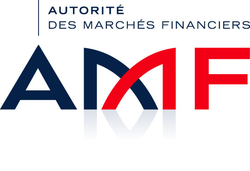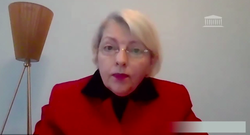The recent news
March 8, 2021
Compliance: at the moment

<iframe src="https://www.linkedin.com/embed/feed/update/urn:li:share:6774085822808387584" height="589" width="504" frameborder="0" allowfullscreen="" title="Post intégré"></iframe>
March 6, 2021
Compliance: at the moment

<iframe src="https://www.linkedin.com/embed/feed/update/urn:li:share:6774227148463996928" height="1013" width="504" frameborder="0" allowfullscreen="" title="Post intégré"></iframe>
March 5, 2021
Hearings by a Committee or Public organisation

🌐suivre Marie-Anne Frison-Roche sur LinkedIn
🌐s'abonner à la Newsletter MAFR Regulation, Compliance, Law
____
► Référence complète : M.-A. Frison-Roche, "Appliquer la notion de "Raison d'être" à la profession du Notariat", audition par le Conseil supérieur du notariat (CSN), 5 mars 2021.
____
🔴trois ans plus tard, cette démonstration fût reprise et approfondie dans une audition devant le Conseil Supérieur du Notariat à propos de la Compliance, sur laquelle un rapport était élaboré, les notions de raison d'être et de compliance étant intimement corrélées comme cela est montré ci-dessous : consulter la présentation de l'audition de 2024..
____
Résumé de l'intervention débutant l'audition : L'on peut prendre "raison d'être" dans son sens courant et dans son sens plus juridique. Dans son sens courant, il est bien difficile de déterminer ce qu'est une "raison d'être". Le plus souvent on ne le traduit pas, en anglais on dira purpose , c'est-à-dire ce qui caractérise l'être humain par rapport à la machine, comme le souligna Alain Supiot, tandis que la langue japonaise le traduit comme Ikigaï, ce qui va animer la personne. L'on sent bien que le souffle de l'esprit passe dans cette notion, qui anime la personne, la porte dans une action qui ne sera pas mécanique, qui va la dépasser elle-même, la fait tout à la fois se distinguer des autres et se rapprocher de ses alter ego....
Mais le Droit a transformé cette notion, si proche de l'éthique, voire de l'art, par laquelle l'individu est "transporté dans le temps par une action partagée avec quelque uns, en un "conception juridique". Cette expression de "raison d'être" est aujourd'hui estampillée par le Droit. A travers une vision renouvelée de l'Entreprise, désormais portée par la législation. En tant qu'une entreprise, selon une définition fortement développée par Alain Supiot est un "projet commun" qui vise une action commune concrétisant un projet conçu ensemble pour être réalisé dans le futur, l'organisation et les moyens n'étant que le reflet de cela. Dans cette définition de l'entreprise, centrée sur la "raison d'être", l'organisation, les moyens, les pouvoirs et les droits de chacun, les rouages internes et les intérêts extérieurs ne sont pas premiers, ils sont totalement imprégnés par cette "raison d'être". Dire la raison d'être, l'affirmer et savoir précisément ce qu'elle est dessine la régime applicable. C'est pourquoi la "raison d'être" a changé en 2019 le Droit des sociétés et le Droit financier.
Elle fût d'abord adoptée par le rapport que Nicole Notat et Dominique Senard remirent le 9 mars 2018 au Ministre de l'Economie et des Finances en réponse à la question posée par celui-ci : l'entreprise peut-elle contribuer à l'intérêt général ? Et la réponse tînt dans cette expression-là : pourquoi pas, si c'est la "raison d'être" de l'entreprise que de s'arracher à la seule préoccupation de se développer afin de devenir toujours plus riche, d'avoir aussi un projet qui inclut le souci d'autrui, d'un autrui qui n'ait pas pour seul souci l'appât du gain, d'avoir le souci d'un intérêt autre (les autres visant pour les auteurs de ce rapport "l'intérêt collectif" et non plus l'intérêt général), par exemple l'intérêt de la Terre, dont la temporalité excède celle de la vie humaine, si fortunée soit cette vie de l'actionnaire et si somptueuse soit la tombe de celui-ci.
La "raison d'être" est donc une notion juridique. A ce titre le Droit des sociétés a changé et l'on en rend les mandataires sociaux responsables : ils doivent montrer qu'ils ont pris en charge d'autres intérêts. L'article 1833 du Code civil a été modifié dans ce sens. Pour pouvoir remplir les nouvelles obligations qu'engendre l'évolution de leur mandat fiduciaire, cela justifie un élargissement de leur "pouvoir" car il est plus difficile encore de faire le bien d'autrui en plus de que rendre riche les associés. Si en plus il faut se soucier de l'environnement et de l'égalité entre les femmes et les hommes ... Les études pleuvent non seulement sur la pertinence managériale et financière de l'approche (plutôt favorable) mais encore juridique (par exemple lorsqu'il y a une offre publique, l'offreur devrait-il démontrer qu'il ferait plus que le bonheur des investisseurs en se saisissant du contrôle de la société-cible ?).
Parle de "raison d'être", c'est donc appliquer un régime juridique à une organisation. Il est fructueux de prendre l'expression au sérieux, c'est-à-dire au pied de sa lettre juridique, car si le Droit est toujours ancré dans le langage courant, les mots gagnent souvent en rigueur et précision par leur entrée dans l'espace juridique. Dans le Droit des sociétés, on a pu critiquer la notion en tant qu'elle diluait la notion d'intérêt social dans de l'insécurité juridique, mais cela permet aussi à l'organisation en cause d'avoir plus de liberté pour poser par sa volonté propre ce pour quoi elle consacre ses prérogatives. Puisque c'est l'entreprise elle-même qui va pose publiquement quelle est sa "raison d'être" (comme elle a posé son objet social)
La "raison d'être" a été conçue pour une "entreprise", pour laquelle la "personnalité morale" a été définie comme n'étant qu'un instrument juridique qui lui permet d'accéder au commerce juridique, selon l'acception retenue par le rapport Notat-Senard. Le Droit va donc vers de plus en plus de "réalisme".
Le notariat se prête particulièrement bien à la notion juridique de "raison d'être". Pour trois raisons. En premier lieu, parce que le Notariat est une profession et que les professions sont des organisations qui sont souvent animées par des projets communs, un esprit commun. C'est même précisément cela que le Droit de la concurrence leur reproche, cette "entente" autour d'une communauté de valeurs, cristallisée par des règles d'organisation (même si l'évolution de ce Droit dans le bon accueil de l'organisation des "groupes de sociétés", notamment face à un appel d'offre montre que cette branche du Droit évolue).
En deuxième lieu, une étude notariale est une entreprise. Pourquoi ne pas l'admettre, et même prendre appui sur cela ? Parce que le Droit des sociétés a si fortement évolué avec la loi Pacte, l'on pourrait considérer que structurellement une étude notariale est une "entreprise à mission". Ce qui doit conduire la profession à étudier de très près ce statut emprunté au Droit britannique, droit incontestablement libéral qui conçoit qu'une entreprise se développe et fasse un chiffre d'affaires, mais pas que.
En troisième lieu, les entreprises à mission se développent dans une architecture institutionnelle par laquelle elles doivent donner à voir l'effectivité de la concrétisation de leur mission. Il a donc deux impératifs : dire exactement quelle est cette mission en amont et donner à voir à tous (et pas seulement à l'Etat) que cette mission, qui justifie de s'écarter du Droit commun de la rencontrer de l'offre et de la demande) est remplie : cela est confiée à la "profession", cadre institutionnel indispensable qui exerce un contrôle permanent (et non pas des contrôles ponctuels comme le font les Autorités de concurrence).
Dès lors, si l'on observe que l'étude notariale a une activité économique de service, ce qui est le cas, elle est légitime comme toute entreprise à avoir une "raison d'être", voire à être une "entreprise à mission". Si en outre, elle appartient à une "profession", elle est alors imprégnée de la "raison d'être" de celle-ci, ce qui n'entame pas sa nature d'entreprise (I). Les professions ne se ressemblant pas et la "raison d'être" donnant à chacun son identité, il convient de prendre au sérieux celle du Notariat pour en tirer à l'avenir les conséquences techniques (II).
Lire le plan de l'intervention ci-dessous.
March 4, 2021
Compliance: at the moment

<iframe src="https://www.linkedin.com/embed/feed/update/urn:li:share:6772922719328579584" height="893" width="504" frameborder="0" allowfullscreen="" title="Post intégré"></iframe>
March 4, 2021
Compliance: at the moment

<iframe src="https://www.linkedin.com/embed/feed/update/urn:li:share:6771321538693083136" height="584" width="504" frameborder="0" allowfullscreen="" title="Post intégré"></iframe>
March 3, 2021
Teachings : Banking and Financial Regulatory Law - Semester 2021

Résumé de la leçon. Dans son lien avec la gouvernance, le Droit de la régulation bancaire et financière a l'ambition d'organiser la façon dont les pouvoirs s'organisent au sein des entreprises, son prisme le conduisant à orienter cette gouvernance vers la protection de l'épargne, des investisseurs et des marchés. Imprégnant ainsi le Droit des sociétés, c'est contre cela que le rapport Notat-Senard a réagi, puis ce que la loi dite PACTE du 22 mai 2019 a cristallisé.
Il demeure que si la société est cotée, ce qui ne correspond pas à toutes les entreprises, le Droit de la régulation continue à influer cette gouvernance à travers le principe de transparence. Celui-ci accroit son emprise lorsqu'il y a une perspective de changement de contrôle. En effet les marchés financiers ne sont pas que des marchés de rendements pécuniaires : ils sont aussi des marchés de pouvoirs, ce qui renvoie à la double nature du titre de capital : son titulaire peut revendiquer des droits patrimoniaux (potentiels) mais aussi des droits politiques actifs, même s'ils n'emportent pas forcément pouvoir de décision.
Ce marché du pouvoir et du contrôle des sociétés est par excellence le marché boursier. Les prises de contrôle, qui pourraient en rester à la nature de contrats d'achat et de vente, sont entièrement gouvernées par l'Autorité de Régulation. L'on part donc du principe d'une offre, mais il peut arriver que cette offre d'achat (ou d'échange) devienne "obligatoire", lorsque des seuils de prise de contrôle sont déjà atteints. Même lorsque des textes interviennent dans un sens libéral, comme en ce qui concerne le contrôle des montants proposés par les offreurs dans le mécanismes d'OPA ou d'OPE les directives de l'Union européennes demandant à ce que les Régulateurs ne contrôlent plus le caractère "équitable" de celui-ci, les juges admettent que par le visa de l'office général du Régulateur et la bonne information de l'actionnaire un tel contrôle soit maintenu, voire accru (cas Altice).
Le marché financier pénètre déjà dans cette régulation des pouvoirs sociétaires lorsque la société est "exposée" au marché financier par la cotation de ses titres sociaux, ou par le mécanisme plus général de financement de marché, les investisseurs titulaires de titres de créance demandant le bénéfice de la même transparence, voire des droits politiques analogues à ceux dont bénéficient les titulaires des titres de capital. Mais les entreprises, à travers leur structuration sociétaire, sont définitivement "ouvertes" lorsque leur capital, c'est-à-dire non seulement leur richesse mais encore le pouvoir politique, est disponible sur ce marché financier spécifique qu'est le marché boursier. Le Droit régule alors les procédés de "prise de contrôle", tâche première de l'Autorité des marchés financiers, car si le pouvoir est par principe disponible, la "loi des volontés" ne peut suffire. L'on retrouve alors, mais sous une forme plus nette, les lois du capital, des volontés et des intentions.
Le Droit pose en effet le principe même des "offres publiques", les opérateurs devant tout d'abord révéler leur "intention" de prendre le contrôle, puis devant offrir à tout actionnaire une contrepartie soit en argent soit en titres. Dans cet achat du pouvoir, le Régulateur boursier joue un rôle central, mais les textes européens dans une perspective plus libérale que précédemment ont posé qu'il n'a pas à contrôler le caractère équitable du prix que l'initiative de l'offre propose, concentrant davantage son pouvoir sur l'information due aux personnes "intéressées", ce qui est excède le seul cercle des titulaires des titres de capital, pour concerner le cercle de la catégorie qui commence à s'implanter dans le nouveau Droit des sociétés qui se dessine : les "parties prenantes". Par la régulation des "prises de contrôle des sociétés ouvertes", l'on quitte de plus en plus l'idée d'une Régulation jouxtant l'économie administrée, parce qu'il s'agirait de la puissance étatique tenant les structures du marché financier afin que celui-ci soit fiable, le premier principe étant la transparence, pour aller vers une Régulation jouxtant la "Gouvernance" des sociétés qui sont exposées aux marchés financiers et qui à ce titre doivent admettre que leur fonctionnement politique doit être transparent, notamment au regard du futur de l'entreprise, voire partagé avec ceux qui ont un intérêt financier avec ce fonctionnement, voire avec également ceux qui y ont un intérêt non directement financier. En cela, le Droit de la Régulation des marchés financiers, en procéduralisant et en contrariant le fonctionnement trop brutal de ceux-ci, est le bastion avancé d'un fonctionnement plus général des sociétés, de nombreuses dispositions ayant tendance à être bilatéralisées dans le Droit des sociétés non-cotées, puisque cette distinction n'existe pas formellement par ailleurs dans le Droit des sociétés.
Revenir aux bases avec le Dictionnaire bilingue du Droit de la Régulation et de la Compliance
Revenir au plan général du cours de Droit de la Régulation bancaire et financière
Revenir à la présentation générale du cours de Droit de la Régulation bancaire et financière
Utiliser les matériaux ci-dessous pour aller plus loin et préparer votre conférence de méthode.

Feb. 25, 2021
Publications

Référence complète : Frison-Roche, M.-A., La "crise économique", la concevoir et intégrer ouvertement de l'insécurité juridique. Comment la concevoir ? Quel régime juridique concevoir pour une insécurité juridique admise, voire requise ?
Ce document de travail a été élaboré pour servir de base à une intervention : L'avenir de la notion d'insécurité juridique au regard du traitement des situations extraordinaires : crise économique, dans le colloque "Insécurité juridique : émergence d'une notion ?, Cour de cassation, 22 mars 2021, Paris.
___________
"whatever it takes"!footnote-2054. Mario Draghi, par cette formule visait en 2015 l'objectif de défense de la monnaie européenne, lorsque l'Euro risquait de s'effondrer sous la danse des spéculateurs enrichis de son effondrement. On a rarement fait formule plus violemment politique et plus fortement normative. Elle a participé à le faire surnommer comme dans le jeu vidéo "Super Mario". La formule a été reprise en 2020 par le Président de la République Française face aux désordres financiers engendrés par la crise sanitaire ayant engendré de semblables calculs!footnote-2055. Elle excède le seul "coût financier"!footnote-2057. Par cette formule, le président de la Banque Centrale Européenne, a posé que la situation de crise économique était telle en Europe que tout pour y mettre fin y serait déployé par l'Institution, sans aucune limite ; que tous ceux qui par leurs comportements, même appuyés sur leurs prérogatives juridiques, en l'espèce les spéculateurs, parce qu'ils détruisaient le système économique et financier, allaient buter sur cela et seraient eux-mêmes balayés par la Banque Centrale car la mission de celle-ci, en ce qu'elle est d'une façon absolue la sauvegarde de l'Euro lui-même, allait prévaloir "quoi qu'il en coûte".
A un moment, le maître se lève. Si la position royale est la position assise lorsque, pondéré, il écoute et juge, c'est en se levant qu'il montre son acceptation d'être aussi le maître parce qu'il est en charge de plus et qu'il fera usage de tout pour gagner.
A situation financière exceptionnelle, tous les moyens de politique monétaire sont donc bons. C'est ce qui fût dit. Sans aucune limite. Et ce ne n'est pas un principe comme celui de la sécurité juridique, ayant permis à des personnes de jouer de leurs droits, par exemple celui de spéculer, d'engranger par avance des prérogatives sur la situation de demain, qui aurait pu empêcher cette puissance de jure permettant de sauver l'Europe. Car à prendre littéralement la formule, même si c'est au prix des droits acquis et des règles précédemment posées qu'il aurait valu payer, s'il avait valu faire page blanche pour en écrire de toutes nouvelles pour sauver l'Europe, la plume de Draghi les aurait tracées sans s'arrêter à cela. Ainsi, par une telle formule c'est par la Grande Porte, celle de la crise économique et financière, que l'insécurité juridique est entrée dans le Droit.
Dans le cas de la crise de 2008, la parole suffît puisque la perspective d'une intervention sans limite du pouvoir monétaire sans limite de la Banque centrale fit que les agissements spéculatifs dévastateurs ne déferlèrent pas. Avoir levé la règle de Droit en ce qu'elle suppose la limite en affirmant qu'il y aurait prévalence absolue du but, suffît donc en Ex Ante pour que la crise ultime ne s'ouvre pas. Cet épisode, digne d'Homère, suffit à éclairer l'insécurité juridique par une de ses dimensions lorsqu'elle est non seulement admissible mais requise : elle peut constituer un acte héroïque.
Dans une telle perspective, plutôt que de laisser l'insécurité juridique dans l'ombre ce qui ne serait qu'une sorte d'imperfection (parce que l'insécurité juridique ne serait donc que l'imperfection de la sécurité juridique), par l'idée par le "légalisme" devrait avoir des limites, que "le Droit n'est pas tout" et qu'il faudrait savoir "fermer les yeux"..., il faudrait plutôt assumer de dire que certaines circonstances il faut dire haut et fort, c'est-à-dire le dire de jure , l'insécurité juridique est légitime, licite, conforme à la hiérarchie des normes juridiques.
En cela, dessiner le concept positif de l'insécurité juridique (ce qui ne peut que plaire aux hégéliens), accroît la sécurité juridique : ainsi cela permet d'associer aux hypothèses d'insécurité juridique un régime juridique plus clair. En effet, plutôt que de mettre sous le tapis le Droit, ce qui explique bien des tensions entre le Conseil constitutionnel et le Conseil d'Etat d'une part et le Législateur et le Gouvernement d'autre part concernant "l'Etat d'urgence", l'on pourrait disposer des conditions dans lesquelles l'insécurité juridique permet d'écarter ou de limiter des règles.
Il est posé comme hypothèse qu'à l'avenir une certaine doser d'insécurité juridique pourrait être ouvertement admise : cela serait donc juridiquement conçu, le Droit gagnant toujours avancer à visage découvert. Même si l'on apprécie la "flexibilité" du Droit, il est toujours dangereux en Droit d'affirmer appliquer des règles tout en ne les appliquant pas.
L'idée proposée est donc que dans des "situations extraordinaires", l'insécurité juridique serait une dimension, voire un principe admissible. Et développant ce premier point il est proposé que l'hypothèse d'une "crise économique" justifie une dimension, voire un principe d' "insécurité juridique".
Mais cette première affirmation est à éprouver. En effet, une crise économique, notion qu'il convient de définir, si elle doit avoir un effet si majeur de retournement, est-elle une "situation" si extraordinaire que cela ?
En outre, pour traiter cette situation extraordinaire que constitue une "crise économique", quelle dose d'insécurité juridique serait juridiquement admissible, voire pourrait être juridiquement revendiquée ? Voire pourrait-on concevoir un renversement de principe qui conduirait le Droit applicable à une crise économique sous l'égide de l'insécurité juridique ?
Dans un tel cas, la question qui se pose alors est de déterminer les conditions et les critères de la sortie de la crise économique, voire de déterminer les éléments de perspective d'une crise économique, qui pourrait justifier par avance l'admission d'injection d'insécurité juridique. Le Droit a avant tout maîtriser sur le temps futur.
Feb. 18, 2021
Hearings by a Committee or Public organisation

🌐suivre Marie-Anne Frison-Roche sur LinkedIn
🌐s'abonner à la Newsletter MAFR Regulation, Compliance, Law
____
► Référence complète : M.-A. Frison-Roche, audition par la Missions Evaluation de la loi dite "Sapin 2" au regard d'une "Europe de la Compliance" et réponses aux diverses questions posées, in auditions menées par par la Mission d'évaluation de la Loi relative à la transparence, à la lutte contre la corruption et à la modernisation de la vie économique, la loi dite "Sapin 2" dirigée par les députés Raphaël Gauvain et Olivier Marleix, Assemblée nationale, 18 février 2021.
____
L'Assemblée Nationale a confié à cette mission "d'établir un bilan approfondi des principaux apports de la loi "Sapin 2" et, si cela apparaît nécessaire, de proposer des pistes d'amélioration".
Regarder la video de l'intervention.
____
Se reporter à la présentation générale de la mission d'évaluation.
Se reporter à l'agenda de l'ensemble des auditions.
____
Lire ci-dessous les points essentiels sur lesquels s'est appuyée la présentation préalable de quelques minutes, centrée sur les points de méthode au regard de la perspective européenne, avant que le temps ne soit utilisé pour répondre aux questions posées par Messieurs les députés Raphaël Gauvain et Olivier Marleix.